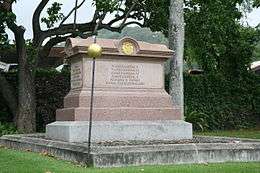Pūloʻuloʻu
Pūloʻuloʻu, often called "kapu sticks", are symbols denoting the kapu of Hawaiian aliʻi (chiefs or royals) and symbolizing the deceased ancestors of the aliʻi. They are traditional symbols of authority which are used in modern times including the Seal of the State of Hawaii.
.jpg)
History
Pūloʻuloʻu are often called "kapu sticks". They were symbol of the authority and protection of the aliʻi (chiefs) of Ancient Hawaii and also represented the mana (spiritual power) of the aliʻi.[1][2] It was made by wrapping bundles of kapa cloth on a stick. They were given ancestral names and placed in areas of prominence. They represented the ancestors of an aliʻi who had died and return from Po (heaven). The round shape denoted the shape of stars as seen from the traditional Hawaiian perspective. They often contain the relics of deceased ancestors such as bones, teeth, hair and other important remains.[3] Their use as symbols of the kapu was introduced by Paʻao, a high priest (kahuna nui) from Kahiki.[4]
The pūloʻuloʻu were often placed at the residence of the aliʻi, at a heiau (temple) and at the burial sites of the aliʻi.[5][6] Whaling captain Alfred N. Tripp gave King Kalākaua a pūloʻuloʻu made of a narwhal tusk on the occasion of the king's 1883 coronation.[7][8] The tusk, which measured seven feet two inches, was capped with a golden sphere and is currently displayed in the throne room of ʻIolani Palace between the two thrones of Kalākaua and Queen Kapiʻolani.[7][8] The pūloʻuloʻu are also displayed at the Royal Mausoleum of Hawaii at Mauna ʻAla where they are placed in the chapel and where metal representations are placed outside the chapels and the crypts.[9]
The coat of arms of the Hawaiian Kingdom and the seal of the State of Hawaii features the pūloʻuloʻu as a symbol of authority.[2][10]
Gallery
_(cropped).jpg) Pūloʻuloʻu used at the funeral of Queen Liliʻuokalani
Pūloʻuloʻu used at the funeral of Queen Liliʻuokalani Metal representation of pūloʻuloʻu outside the Kamehameha Tomb at the Royal Mausoleum of Hawaii at Mauna ʻAla
Metal representation of pūloʻuloʻu outside the Kamehameha Tomb at the Royal Mausoleum of Hawaii at Mauna ʻAla.jpg) Metal representation of pūloʻuloʻu made with a narwhal tusk at ʻIolani Palace
Metal representation of pūloʻuloʻu made with a narwhal tusk at ʻIolani Palace Coat of arms of Hawaii
Coat of arms of Hawaii
See also
References
- Kamehiro, Stacy L. (2009). The Arts of Kingship: Hawaiian Art and National Culture of the Kalākaua Era. Honolulu: University of Hawaii Press. p. 262. ISBN 978-0-8248-3263-6. OCLC 663885792.
- Dutton, Meiric Keeler (1960). Hawaii's Great Seal and Coat of Arms. Honolulu: Loomis House Press. p. 14. OCLC 16321549.
- Pacific Worlds (2003). "Pūloʻuloʻu". Pacific Worlds. Archived from the original on March 28, 2020. Retrieved March 27, 2020.
- Gross, Jeffrey L. (2017). Waipiʻo Valley: A Polynesian Journey from Eden to Eden. Indiana: Xlibris US. p. 426. ISBN 978-1-5245-3905-4. OCLC 1124453477.
- Kanahele, George S. (1999). Emma: Hawaii's Remarkable Queen. Honolulu: University of Hawaii Press. p. 4. ISBN 978-0-8248-2240-8. OCLC 40890919. Archived from the original on May 8, 2016. Retrieved March 28, 2020.
- Kalākaua, David (1888). Daggett, Rollin Mallory (ed.). The Legends and Myths of Hawaii: The Fables and Folk-lore of a Strange People. New York: C.L. Webster & Company. pp. 32–33. OCLC 1036300398. Archived from the original on June 5, 2017. Retrieved April 20, 2020.
- "The Coronation". The Pacific Commercial Advertiser. Honolulu. February 17, 1883. p. 2. Retrieved December 29, 2018.
- Houston, James D. (November 23, 1986). "Palace of the Last Hawaiian King". The New York Times Commercial Advertiser. Honolulu. Archived from the original on May 24, 2015. Retrieved December 29, 2018.
- Pacific Worlds (2003). "Mauna ʻAla". Pacific Worlds. Archived from the original on January 31, 2009. Retrieved March 27, 2020.CS1 maint: ref=harv (link)
- Bose, Purnima; Lyons, Laura E. (2010). Cultural Critique and the Global Corporation. Bloomington; Indiana: Indiana University Press. p. 99. ISBN 978-0-253-30029-4. OCLC 1131657944.
External links
![]()